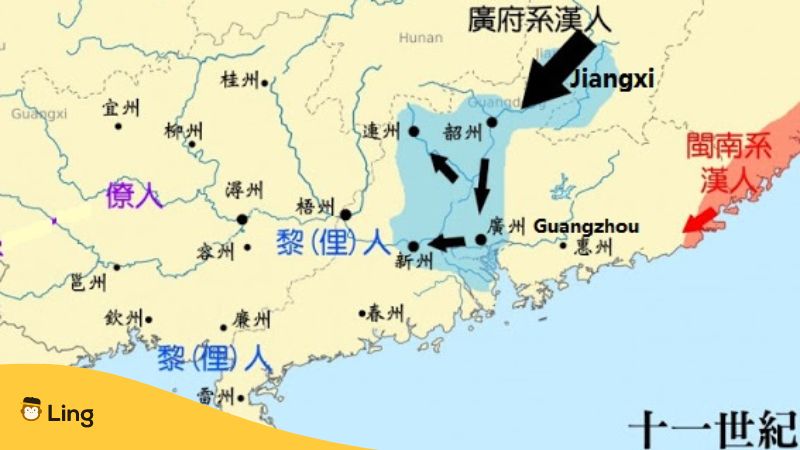Are you planning a trip to a Cantonese-speaking country like Hong Kong? Well, what better way to immerse yourself in the local culture than by learning the history of Cantonese? Trust me, it’ll be a real blast!
Now, I know what you’re thinking: “What even is Cantonese?” Well, my friend, let me give you a quick overview. Cantonese is a dialect of the Chinese language spoken primarily in the Guangdong province of China, as well as in Hong Kong, Macau, and various diaspora communities around the world. It’s also one of the most widely spoken Chinese dialects and has a rich cultural and historical significance.
The Cantonese language, spoken in cities like Hong Kong and Macau, has played a pivotal role in shaping Chinese culture and society, both in China and beyond. It has a rich literary and cultural tradition, with a wide range of classic works of literature, poetry, and drama.
But perhaps most importantly, Cantonese is a language that reflects the unique history and identity of the Cantonese people. It’s a language that has survived centuries of political and cultural upheaval and has emerged as a symbol of resilience, pride, and cultural heritage.
So, buckle up and get ready for a wild ride, because we’re about to take a deep dive into the history of Cantonese language.

History Of Cantonese – Origin
Cantonese is a dialect of Chinese that has its origins in the southern Guangdong province of China, which is located along the coast of the South China Sea. If you had doubts about the geographical origin of Cantonese, then think how Cantonese literally means people of Canton City (Guangzhou).
Now, the origins of Cantonese are shrouded in mystery, but one thing we do know is that it emerged as a distinct dialect of Chinese during the Tang Dynasty, way back in the 9th century. That’s right, we’re talking about some serious old-school stuff here.
But let’s start from the beginning: it all started during the late Tang Dynasty and after its collapse. During this period, civil wars were spreading like wildfire in Northern mainland China, leading to a large wave of Han Chinese migrating South to the Pearl River Delta around Guangzhou.
At the time, an ethnic Tai people group called Tanka lived in the region. However, Chinese immigrants from the North quickly outnumbered the Tanka.
Eventually, the Tai people gradually adopted the protoforms of Cantonese while still preserving elements of their proto-Tai language. As a result, the dialect now known as Cantonese emerged.

Characteristics Of The Cantonese Language
So, what set Cantonese apart from other Chinese dialects? Well, for starters, it’s all about geography, baby. Cantonese is spoken in the Guangdong province of Southern China, which is a hop, skip, and jump away from the South China Sea. This proximity to the sea, combined with a long history of trade and commerce, helped shape the unique linguistic features of Cantonese.
This area was a hub of maritime trade and commerce, which brought together people from different regions and cultures, leading to a true hot pot of cultural exchange. Like any other language, this led to the development of a unique linguistic blend that incorporated elements from various Chinese languages and dialects, as well as foreign languages like Portuguese and English.
One of the most notable features of Cantonese is its tonal system, which is notoriously difficult for non-native speakers to master. Cantonese has a whopping nine tones, which means that the same sound can have completely different meanings depending on the tone used. This tonal system likely evolved as a way for speakers to communicate effectively in the noisy and chaotic environment of a bustling seaport. Talk about a linguistic rollercoaster ride!

Standardization Of The Cantonese Language
While Cantonese has a rich history that stretches back centuries, efforts at standardization were only effective in the 20th century. Before this, unlike standard Chinese, Cantonese was primarily a spoken language, with no standard written form or unified system of pronunciation.
However, with the rise of modern China and the increasing importance of Cantonese in commerce and culture, there was a growing need for a way to write it.
In 1932, the first official system of Cantonese Romanization, called the Yale Romanization System, was created by linguists at Yale University. This system used English letters to represent the sounds of Cantonese, making it easier for non-native speakers to learn and understand the language.
Over time, other systems of Romanization were developed, including the widely-used Jyutping system. In addition to Romanization, efforts were made to standardize the written form of Cantonese, with the creation of a set of Chinese characters specifically for the dialect.
All these efforts have had a significant impact on the development and spreading of the language across the globe, helping to create a unified and standardized version of the language that can be taught to new language learners.
However, like everything in the world, this evolution of the language could not happen without a little bit of resistance and controversy. Some native Cantonese speakers claim that the adoption of this version of pronunciation and writing could lead to the loss of unique regional features and variations. Additionally, there has been debate over which system of Romanization or writing should be considered the “official” standard for Cantonese.
Despite all these ups and downs in the standardization process of Cantonese, these efforts were vital to help this language to grow and develop into what it is today. A language that is sought by people around the world, and that has a version that can be shared and learned, always maintaining its unique regional variations and cultural heritage. A pretty cool situation for a very popular language, if you ask me.

Cantonese In Hong Kong
If you’ve ever been to Hong Kong, you know that Cantonese is the language of choice for most of the city’s inhabitants. In fact, it’s estimated that around 90% of the population speaks Cantonese as their first language. It is actually the official language of this region.
But how did Cantonese come to be the dominant language in Hong Kong? Well, it all goes back to the city’s history as a major trading port and British colony.
During the 19th century, Hong Kong became a hub of international commerce, with traders and merchants from all over the world flocking to the city. This led to a rich and diverse cultural melting pot, with languages and dialects from all over the world being spoken on the streets of Hong Kong.
However, as the British colonial influence grew stronger, Cantonese began to emerge as the dominant language in the city. This was partly because Cantonese was the language spoken by the majority of Hong Kong’s Chinese population, but it was also influenced by the colonial authorities’ efforts to promote the use of English and Cantonese over other Chinese dialects.
Today, Cantonese is the primary language of communication in Hong Kong, and it plays a crucial role in the city’s culture and identity. From street vendors and taxi drivers to businesspeople and Hong Kong government officials, Cantonese is the language of choice for almost everyone in the city.
In fact, the use of Cantonese in Hong Kong is so ingrained in the local culture that it has even led to the creation of a unique dialect known as “Hong Kong Cantonese.” This dialect features its own distinctive slang, pronunciation, and grammar rules, and it has become an important part of the city’s cultural identity.

Modernization And Globalization Of Cantonese
As the world becomes more interconnected, and globalization continues to shape the way we communicate, Cantonese has had to adapt to the changing linguistic landscape.
In recent years, the influence of English and Mandarin has become more pronounced in Hong Kong, and Cantonese has had to compete with these languages for dominance in certain spheres, such as business and international diplomacy.
But you know what they say: when the going gets tough, the tough get going. And Cantonese is one tough cookie! One of the key factors driving the modernization and globalization of Cantonese is the rise of technology. With social media and instant messaging apps blowing up, Cantonese speakers around the world are more connected than ever. These savvy tech wizards are leading the charge in promoting the language to new audiences across the globe.
Of course, there are still challenges facing the Cantonese language in the modern era. It ain’t all sunshine and rainbows for Cantonese, oh no. The rise of Mandarin as a global language, and the increasing pressure to learn English in order to succeed in the global economy, have created a difficult environment for Cantonese to thrive in.
But you know what? Cantonese ain’t no one-hit-wonder. With its resilient and adaptable speakers, the language will continue to hold its own in the linguistic and cultural scene.
From Tang Dynasty To Today – Here Is Cantonese
Well, folks, it’s been a wild ride exploring the rich history of Cantonese in this article. We’ve learned all about its origins, its standardization, its use in Hong Kong, and its modernization and globalization. From ancient roots to modern-day tech-savvy coolness, Cantonese has seen it all.
Learn More Cantonese With The Ling App
With the world becoming more and more connected, Cantonese is becoming a popular language to learn for business, travel, and just for fun. And what better way to learn than with Ling, the best language-learning app out there.
With Ling, you’ll be able to pick up Cantonese faster than a cheetah on roller skates. You’ll learn all the essential phrases and slang, and before you know it, you’ll be impressing your friends with your newfound linguistic skills.
So don’t wait until Cantonese becomes the next big thing to jump on the bandwagon. Be a trendsetter and start learning Cantonese today with the Ling app. Trust us, your coolness factor will thank you later.
下次見!(xia4 ci4 jian4)
See you next time!


































































